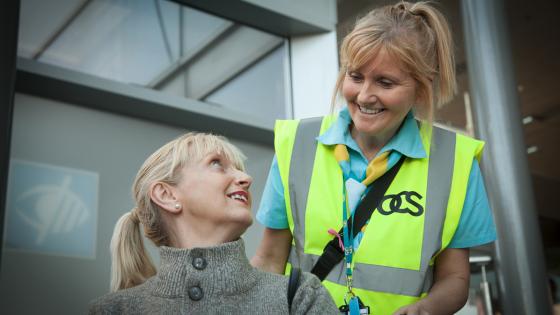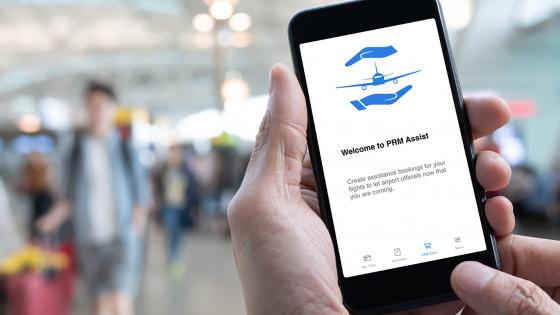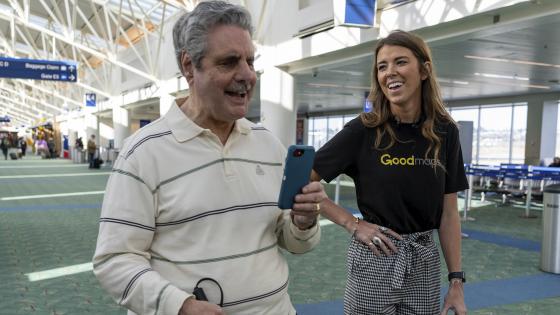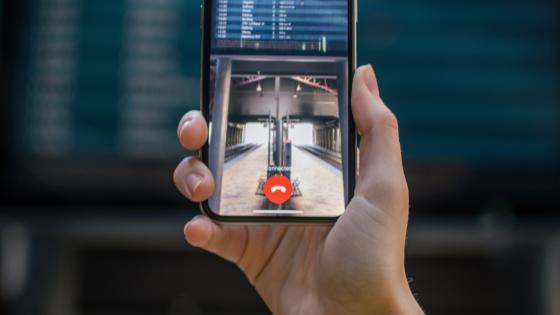How are apps making it easier for less mobile passengers to travel through an airport independently? Mark Broadbent reports.
The United Nations estimates more than one billion people, or around 15% of the world’s population, live with a disability. According to Airports Council International, “this prevalence is expected to increase due to demographic trends and increases in chronic health conditions, among other factors”.
Identifying and removing barriers for passengers with reduced mobility (PRMs) is essential for any provider of transport connectivity. It is imperative that operators of major public transport infrastructure provide well-designed environments and appropriate services.
Supporting disabled travellers takes many forms in the airport environment. Examples include installing barrier-free access points, ramps and tactile paving, ensuring there are high-resolution screens for those with visual problems, assisted boarding and disembarkation, and ensuring personnel training and evacuation plans fully account for people with disabilities.

While passenger assist schemes are important, apps increasingly enable passengers with reduced mobility to navigate the airport independently
The big picture
Disability brings added complexity to any travel experience. For PRMs, an airport is an especially demanding environment, from check-in and security processing to accessing airside facilities, travelling to gates and to baggage reclaim at the destination.
“Transport hubs are the second most requested category of places demanded by our user community for detailed accessibility information,” a spokesperson from the UK-based organisation AccessAble – which assesses venues across the UK for accessibility – told Airports International, adding: “Airports are a leading category of user traffic, with our website being used by over five million people each year.”
The mission statement of Irish firm PRM Assist is: “To empower people with reduced mobility through new technology, and allow them to take control of their own journeys around the globe.” According to its CEO, Conor Halpin, for disabled passengers “the biggest issue remains the lack of certainty that assistance will be provided to them on the day” they use an airport.
This issue is not easily fixed and involves communication and collaboration from multiple stakeholders involved in the passenger’s journey
Halpin said: “From a departures perspective the issue is not as prevalent. However, upon arrival into the passenger’s destination airport, we commonly see delays to assistance – or lack of [assistance] – forcing PRMs to navigate the airport terrain themselves.”
He added: “This issue is not easily fixed and involves communication and collaboration from multiple stakeholders involved in the passenger’s journey.”
There is a lack of consistency in the airport user experience for disabled travellers, Halpin said: “Challenges for a passenger with disabilities can vary depending on the airport they are arriving at or departing from. Many airports, specifically older airports, struggle from an accessible infrastructure perspective.”
He continued: “It can also vary depending on the passenger’s disability. This is why it’s important to constantly engage with passengers’ groups and receive feedback to ensure your airport is always up to date and making changes to make every passenger’s journey as smooth as can be.”

The PRM Assist app can provide passengers with real-time flight information, as well as enabling them to request specific special assistance and provide feedback
In 2022, Airport Councils International (ACI) World introduced its Accessibility Enhancement Accreditation programme, to provide “a continuous path of improvement” for airports in the area of accessibility.
ACI explained: “It is designed to help airports measure, evaluate and improve their accessibility management and culture. It enables airports to demonstrate to airport users, regulators and the aviation ecosystem that they are implementing international best practices and recommendations.”
The only international assessment or accreditation solely dedicated to airports’ accessibility for disabled passengers, the programme assists airports in implementing existing global best practices and recommendations on accessibility, including those in the ACI Airport and Persons with Disability Handbook.
Fundamentally, PRMs (including this author) want to know how safely and independently they will be able to move around an airport
Airports applying for the accreditation must submit evidence including a questionnaire and operating procedures, forms and photographs. They must also undertake a virtual evaluation to determine if the airport is applying a systematic management approach and whether accessibility-related best practices are being met. The accreditation is valid for three calendar years after which, to remain accredited, airports must submit a new application.
AccessAble
Fundamentally, PRMs (including this author) want to know how safely and independently they will be able to move around an airport.
They want to know how easily they will be able to use facilities and exactly what the accessibility challenges are. Those challenges could include poor lighting in a certain part of a terminal, a particularly long distance from an accessible toilet to the departure lounge, small ramps on journeys to the gate, barriers that might block a path, awkward steps, poor signage or illegible monitors/screens. Above all, they want to know about the solutions the airport provides.
So how do apps help? Numerous examples are now available that PRMs can use to help inform them about the specific layouts, facilities, processes and procedures at an airport, and the help that may – or may not – be available.
AccessAble’s online guides, for example, combine reports compiled by trained surveyors with reviews and photographs collected by its user community, and can be downloaded via the app.
The guides provide detail on everything from parking and walking distances to restaurants and cafes, quiet spaces, accessible toilets and hearing loops.
An AccessAble spokesperson told Airports International: “We work with nine of the UK’s major airports to produce Accessibility Guides which are 100% facts, figures and photographs. We know everyone’s accessibility needs are different, which is why having detailed, accurate information is so important.
“We have developed bespoke Access Guide templates for airports and provide accessibility information from arrivals and departures perspectives.
“Each airport partner has their Accessibility Guides published and promoted on the AccessAble website and app. The guides are also integrated into the airport’s own website to ensure people find the information they need where they expect it to be.”
Being a facility spread across multiple floors and potentially miles of thoroughfare, an airport is likely the most complex building you’ll navigate
PRM Assist and WelcoMe
PRM Assist is an app that enables passengers to receive booking confirmations from airport officials, view details about their flights and receive announcements about waiting times, delays and assistance information.
The app holds the passenger’s booking information in one place with departure times, terminal and gate numbers. Waiting times are communicated in real time using what the developer calls its “innovative beacon technology”.
WelcoMe is a cloud-based platform developed by Edinburgh-based developer NeateBox. As well as browsing venues to check accessibility features, the app enables PRMs to set up a personalised accessibility profile listing their individual needs.
Users are able to communicate their requirements to destinations signed up to the app ahead of their visit – enabling a venue’s customer service team to learn in advance of the user’s requirements so they can make the appropriate arrangements to accommodate them properly.
WelcoMe “specialises in making face-to-face transactions between staff teams and disabled people as informed, anxiety-free and friendly as possible” for PRMs, the developer claims, adding that the service “promotes inclusion and equality” and “recognises that all parties need support and [are] prepared for your visitor’s arrival”.
PRM Assist’s Halpin told Airports International that the various apps available for PRMs “aid the standard of assistance provided in airports”.
He said: “The use of resource allocation, passenger management and passenger analytics systems increase the standard of service provided to the passengers and ensures greater operational efficiency. For the passenger, [apps] are improving the level of customer service and ensuring a smoother journey.”
Navigational aids
Beyond supplying pre-journey information to customers or connecting travellers with a venue, apps can really come into their own for disabled passengers at the airport.
Evelyn Tichenor, VP of sales and partnerships at GoodMaps, told Airports International: “Being a facility spread across multiple floors and potentially miles of thoroughfare, an airport is likely the most complex building you’ll navigate.
“They can be a nightmare to navigate,let alone enjoy as a comfortable and relaxed experience. If you are a traveller with reduced mobility, the last thing you want to do is make the effort to go all the way to your gate and then find out you are in the wrong place, or if you are blind and you want to be able to get to your gate independently,” she explained.
Apps make a difference in helping PRMs find their way around. GoodMaps produces apps (free of charge to blind users) using GPS technology that generates ‘location-aware’ data able to detect and calculate a person’s geographical position with their mobile device.
The developer claims its app provides accuracy to “within a few feet” of a user’s location, giving the person confidence about exactly where they are and what’s around them. The app then suggests efficient, step-free routings, offers vocal and text-based guidance and provides relevant location-based information about refreshment outlets, toilets and lifts.

Apps developed by GoodMaps use GPS technology that generates ‘location-aware’ data able to detect and calculate a person’s geographical position
Tichenor said: “Having access to this information makes a significant difference. Simply finding your gate canbe an enormous inducer of anxiety, let alone locating accessible toilets, lifts or places to eat or drink on your way through an airport.”
Halpin highlighted the “peace of mind” that apps can provide to disabled travellers. This is an especially important concern for PRMs – in this author’s personal experience, knowledge about the facilities and services to be encountered on a journey can give confidence to move around a terminal and use its facilities as a non-disabled traveller would do.
Tichenor added: “While passenger assist is extremely helpful, it’s nothing like being able to autonomously navigate the environment.” She said having an app available on a smartphone that is available at all times means individuals “don’t worry about locating and then using third-party hardware”, adding: “You’re already acclimatised to your device, meaning there’s a reduced learning curve and it’s simple and easy to use.”
The extra difficulties of navigation for visually impaired people have even inspired the development of specialist vision-based apps that use live video calls to link blind and low-vision individuals with sighted volunteers and companies.
Through apps such as Be My Eyes – which has attracted more than six million volunteers since its January 2015 launch – users request assistance from volunteers who then lend their sight to the individual, guiding them via the call.

Danish mobile app Be My Eyes connects more than 6.2 million volunteers with over 450,000 blind and visually impaired people
Opportunities and costs
Apps provide other benefits for PRMs in airports. GoodMaps says its software automatically identifies points of interest determined by GPS co-ordinates and descriptions within the terminal. This generates alerts for users highlighting retail or food and beverage opportunities in the terminal to the user.
PRM Assist’s Halpin said he believes the layout of retail/food and beverage areas “is vital for encouraging engagement from PRM passengers” and he added that apps “increase engagement” between airports and passengers.
NeateBox says its WelcoMe app means operators know a customer’s needs and requirements and can “seamlessly manage, understand and assist disabled customers”.
According to the developer, apps can even bring a new dimension to staff training by providing what it describes as “in the moment accessibility training, hints and tips” on how best to support disabled visitors and customers.
Deeply understanding disabled travellers’ requirements and supporting them makes sound business sense, the AccessAble spokesperson told Airports International, adding that apps “can benefit airports and airlines by increasing revenue, attracting new passengers, saving costs and time and reducing passenger complaints”.
They can also “reduce demand for PRM services and their related costs, offering compliance and legal protection” while “giving a real boost to ROI on the airport’s accessible facilities”, the spokesperson added.
The pandemic has had a positive impact in terms of increasing awareness and developing a call for action to improve the levels of assistance services provided in airports
Tichenor noted: “Apps can also be updated and maintained with minimal effort from either the user or facilities team, meaning you can take advantage of any developments that may occur in the future, as well as correct any issues relatively quickly.”
On its website, GoodMaps says its service “requires no infrastructure or Bluetooth beacons in a building”, adding: “By utilising LIDAR and image recognition, we provide fast and accurate maps of indoor spaces at a fraction of the effort and costs.”
Advancing apps
Tichenor believes the impact of the COVID-19 pandemic has led to far more focus on improving the airport experience: “Not being out and about in public has caused people to feel nervous and anxious when starting to travel again. Post-pandemic, I feel airports are trying to be conscious of the variety of traveller groups and trying to make them feel comfortable in coming back.”
Halpin commented: “The pandemic has had a positive impact in terms of increasing awareness and developing a call for action to improvethe levels of assistance services providedin airports.”
But more needs to be done. “Ultimately, the user experience for most apps can be improved, including our own,” GoodMaps’ Tichenor acknowledged.
She said: “Fine-tuning and developing new and easier ways for users to interact with technology is paramount for accessibility and is central to whether an app is useful or not. Building an app with the accessible experience embedded from the beginning is key, as is designing with the community and not for the community.”
The core functionality of apps is another area that requires more work to provide a better service to customers, Tichenor said: “Can we create a smoother, more cohesive and interconnected app taking advantage of existing SDKs and APIs [software development kits and application programming interfaces]?”
Of course, in addition to apps with accessibility built in at the outset, there exist those built for other purposes then later upgraded with PRMs in mind. Among these is Bebot, a Japanese chatbot whose developers recently expanded its capabilities to include a multilingual guidance service for accessibility. The chat service was on trial at Haneda Airport until March 31, 2023.

Answers can now be read aloud by a screen reader within the Bebot chat service, and an easy-to-read font display matches the user's font-size setting
Infrastructure
PRM Assist Halpin said “there needs to be improvement with the engagement from airports and airlines” on apps, adding: “I would like to see airports engage with creators and businesses; one possibility would be to provide financial support to mobile applications that they believe will be beneficial.”
But Tichenor noted that “there are only so many challenges an app can actually mitigate”. She said: “Most of the other issues faced by PRMs are infrastructure-related – replacing stairs with lifts or travelators, providing accessible amenities, etc – or educational for staff and other travellers.”
However, she added: “Not all buildings have made the infrastructure suitable for a PRM, but if a PRM had an app that could tell them what was and what was not accessible, it would save them a lot of trouble and physical effort in travelling somewhere where the restrooms or entrance may not be accessible.”
Apps may not fix the built environment but they can at least provide the information related to that environment ahead of time
App development should go hand-in-hand with overall terminal design, Halpin said: “Unfortunately, improvement to infrastructure to make it more accessible is often seen as a cost rather than an investment. This needs to change.”
Tichenor concluded: “Apps may not fix the built environment but they can at least provide the information related to that environment ahead of time.
“Being aware of and respecting the requirements of other passengers is paramount to reducing the challenges faced by all people.”
